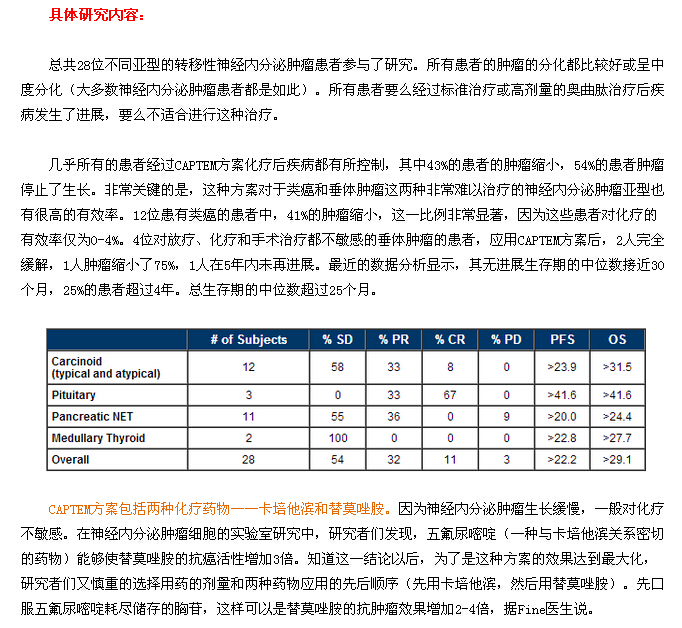本帖最后由 与爱有别 于 2015-6-30 22:59 编辑

 http://news.medlive.cn/cancer/info-progress/show-56936_53.html
http://news.medlive.cn/cancer/info-progress/show-56936_53.html
CAPTEM方案包括两种化疗药物——卡培他滨和替莫唑胺。因为神经内分泌肿瘤生长缓慢,一般对化疗不敏感。在神经内分泌肿瘤细胞的实验室研究中,研究者们发现,五氟尿嘧啶(一种与卡培他滨关系密切的药物)能够使替莫唑胺的抗癌活性增加3倍。知道这一结论以后,为了是这种方案的效果达到最大化,研究者们又慎重的选择用药的剂量和两种药物应用的先后顺序(先用卡培他滨,然后用替莫唑胺)。先口服五氟尿嘧啶耗尽储存的胸苷,这样可以是替莫唑胺的抗肿瘤效果增加2-4倍,据Fine医生说。
作者观点:
Robert Fine教授
该研究的主要作者Robert Fine教授(Robert Fine是纽约哥伦比亚大学医学中心、Presbyterian医院的副教授)表示:在这一研究中,我们看到那些预计只能存活6个月的患者,应用CAPTEM方案后,8年后仍然活着。这一方案甚至对于那些对其他标准治疗方案(包括化疗、高剂量的奥曲肽、小分子抑制剂、放疗或手术)不敏感的肿瘤患者也有效。CAPTEM方案的严重不良反应的发生率很低。没有住院死亡或治疗相关死亡的报道。
摘要原文:
Background: We found in our lab that capecitabine (CAP), the prodrug of 5-FU, and temozolomide (TEM) were synergistic in inducing apoptosis in BON neuroendocrine tumor (NET) cell lines. We were the first to report in 2004 the use and mechanism of action of CAP and TEM (CAPTEM) in well differentiated NETs with promising results. Here we describe the interim analysis of an ongoing Phase II trial.
Methods: 28 patients with metastatic well-moderately differentiated NET (ki-67 ≤20%) who had shown progression only on 60mg Sandostatin LAR (if octreotide scan positive) were treated with the following regimen: CAP 1,500mg/m2/day (PO divided BID, maximum 2,500 mg/day) on d1-14, and TEM 150-200mg/m2/day (PO divided BID, lower dose for patients who had prior chemotherapy or extensive radiation) on d10-14, with the next two weeks off, in a 28 day cycle. Primary objective was RR based upon RECIST, and secondary objectives included PFS, OS (from time of initiation of therapy), and toxicity evaluation. Other inclusion criteria were: age <80, ECOG PS 0-2, and adequate hematologic, renal, and liver function, and failure on high dose Sandostatin LAR.
Results: 28 of 38 planned patients were enrolled with various NET subtypes (table). Overall RR was 43% (11% CR) and SD rate was 54%, with clinical benefit in 97%. ORR was 41% in carcinoid tumors. Ongoing mPFS is >20mo for all subtypes with 18/28 (64%) having progressed at this time. Twelve of 28 had died at this analysis with ongoing mOS of >25.3mo. The most common G3/4 toxicities were lymphopenia (32%), hyperglycemia (15%, unlikely related), thrombocytopenia (3%), and diarrhea (3%). No hospitalizations, opportunistic infections, or deaths occurred from CAPTEM.
Conclusions: CAPTEM is an effective treatment for patients with progressive NET who failed high dose octreotide, with high PR and SD rates in carcinoids and insulinomas. The ongoing PFS in pancreatic NETs (>18.2 mo) is 150% greater than reported with everolimus and sutent.
|